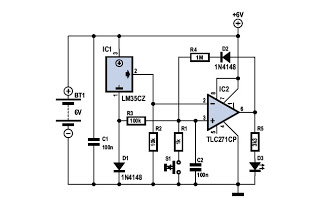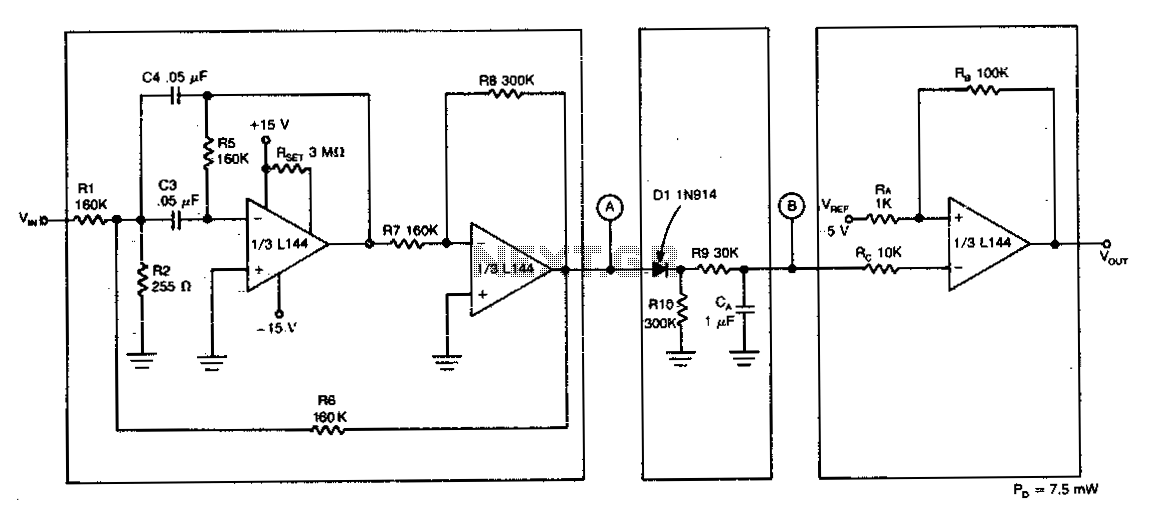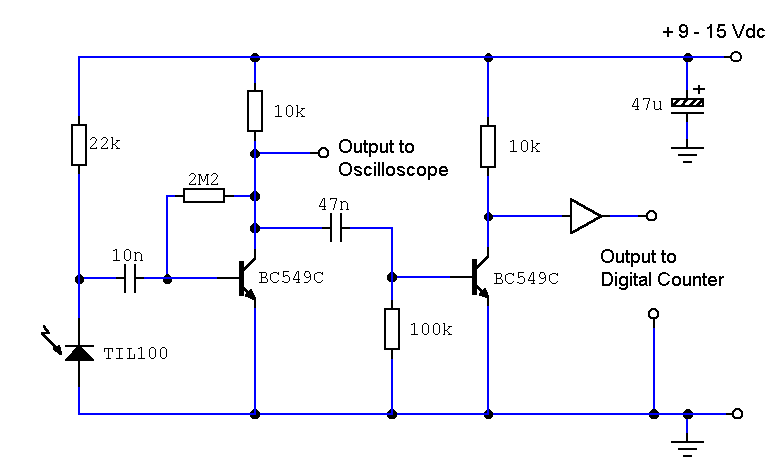
CARBON MONOXIDE DETECTOR

This circuit features a focused optical sensor designed to transmit light to a carbon monoxide (CO) reagent, which subsequently detects the amount of light reflected. The CO detection reagent transitions from a light yellow hue to a darker shade upon exposure to carbon monoxide. According to the manufacturer's specifications, a concentration as low as 100 parts per million (ppm) can cause the detector to darken within a timeframe of 15 to 45 minutes.
The circuit operates by utilizing an optical sensor that emits light towards a specific CO-sensitive reagent. This reagent is formulated to change color in response to the presence of carbon monoxide, providing a visual indication of CO levels. The sensor's ability to detect light reflection is crucial; as the reagent darkens, it absorbs more light, resulting in a measurable decrease in the intensity of light reflected back to the sensor.
The optical sensor is typically composed of a light-emitting diode (LED) and a photodetector. The LED emits light at a specific wavelength that the CO reagent is sensitive to, while the photodetector, often a photodiode or phototransistor, measures the amount of light that is reflected back after interacting with the reagent. The circuit may include additional components such as operational amplifiers to amplify the signal from the photodetector and analog-to-digital converters (ADCs) to process the signal for digital display or further analysis.
Power supply considerations for the circuit are important, as the optical sensor and associated components require stable voltage levels to function correctly. A regulated power supply may be employed to ensure consistent performance. Furthermore, the circuit may incorporate a microcontroller or microprocessor to handle data processing, user interface, and alarm functionalities, alerting users when CO levels exceed safe thresholds.
In summary, this circuit exemplifies a practical application of optical sensing technology in environmental monitoring, specifically for carbon monoxide detection. The integration of colorimetric response from the reagent with optical sensing provides a reliable method for detecting hazardous gas concentrations, ensuring safety in various applications.This circuit has a focused optical sensor to transmit light to the CO reagent, and then sense the amount of light reflected. The reagent for CO detection darkens from a light yellow color when exposed to CO. According to the card`s manufacturer, a concentration as low as 100 parts per million (ppm) will darken the detector after 15 to 45 min.
A concentration.. 🔗 External reference
The circuit operates by utilizing an optical sensor that emits light towards a specific CO-sensitive reagent. This reagent is formulated to change color in response to the presence of carbon monoxide, providing a visual indication of CO levels. The sensor's ability to detect light reflection is crucial; as the reagent darkens, it absorbs more light, resulting in a measurable decrease in the intensity of light reflected back to the sensor.
The optical sensor is typically composed of a light-emitting diode (LED) and a photodetector. The LED emits light at a specific wavelength that the CO reagent is sensitive to, while the photodetector, often a photodiode or phototransistor, measures the amount of light that is reflected back after interacting with the reagent. The circuit may include additional components such as operational amplifiers to amplify the signal from the photodetector and analog-to-digital converters (ADCs) to process the signal for digital display or further analysis.
Power supply considerations for the circuit are important, as the optical sensor and associated components require stable voltage levels to function correctly. A regulated power supply may be employed to ensure consistent performance. Furthermore, the circuit may incorporate a microcontroller or microprocessor to handle data processing, user interface, and alarm functionalities, alerting users when CO levels exceed safe thresholds.
In summary, this circuit exemplifies a practical application of optical sensing technology in environmental monitoring, specifically for carbon monoxide detection. The integration of colorimetric response from the reagent with optical sensing provides a reliable method for detecting hazardous gas concentrations, ensuring safety in various applications.This circuit has a focused optical sensor to transmit light to the CO reagent, and then sense the amount of light reflected. The reagent for CO detection darkens from a light yellow color when exposed to CO. According to the card`s manufacturer, a concentration as low as 100 parts per million (ppm) will darken the detector after 15 to 45 min.
A concentration.. 🔗 External reference





